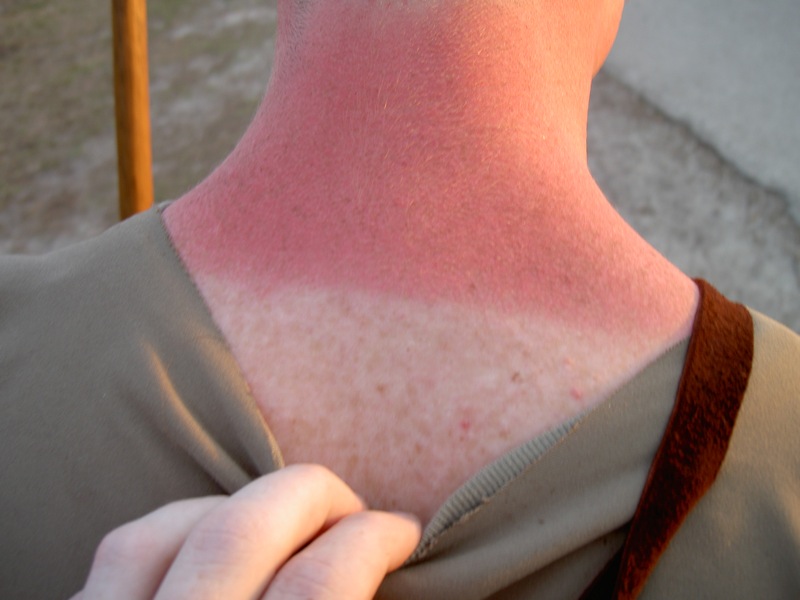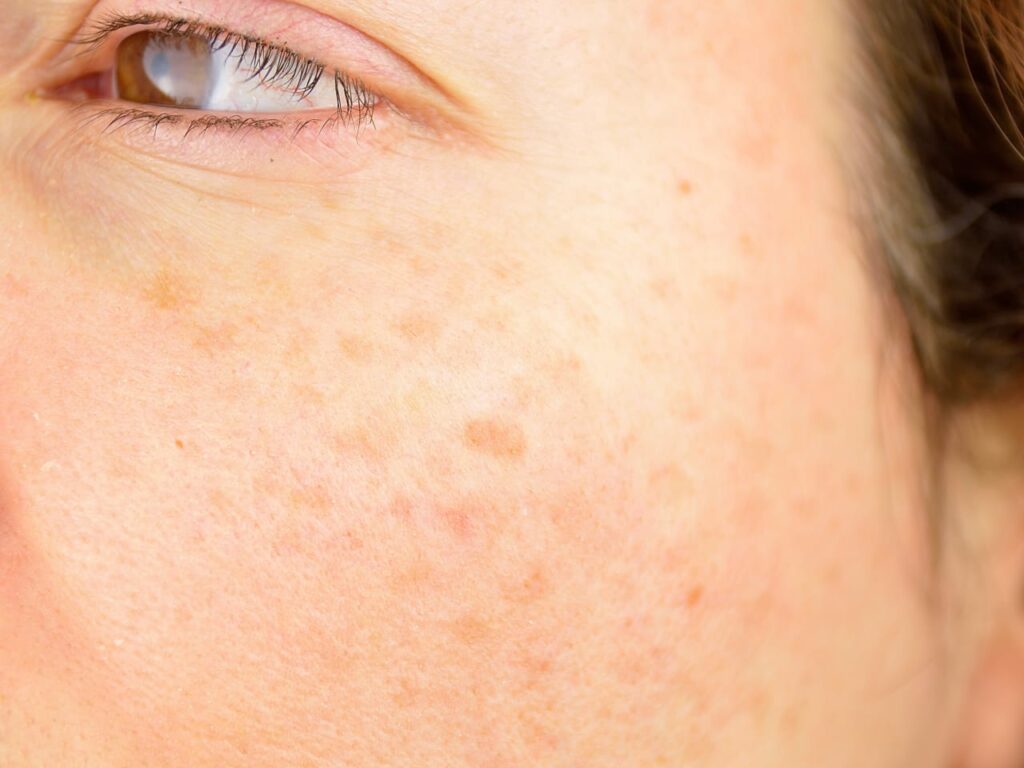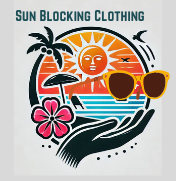“5 Potential Dangers and Risks of Sun Exposure for Fair-Skinned Individuals” is written to help you determine your risk. It is hard to know if you should be concerned or not if you don’t know the risks you face.

You can protect your skin from the sun with properly fitting sun blocking clothing, sunscreen, and a sun-safe lifestyle! It all seems common sense, but looking at growing skin cancer statistics, we know there is more to do.
Too much sun, too little or no skin protection, for too long for people who are high risk often lead to skin cancer. Don’t overlook making your skin age early.
This happens to your skin because of the ultraviolet or UV rays, especially for fair-skinned individuals.
Skincancer.org tells you that fair-skinned people have less melanin. I know you learned that in grade school. However, it has been a year or two. Most of us disregarded the information and moved on to what “everyone else” was doing. Your darker-skinned cousins were playing outside and you did too.
With less melanin, your skin is not as protected naturally as your darker-toned cousins and your skin will react differently. Is it fair? No, it isn’t. That doesn’t change anything.
Sun Exposure and Fair Skin
- Excessive sun exposure, especially ultraviolet radiation, leads to sunburn and increased damage to cells, called oxidative stress.
- This causes skin damage such as inflammation, early skin aging, and tumor development.
- Melanoma and non-melanoma skin cancer rates are rising each year according to statistics from the U.S. National Cancer Institute.
- UV rays cause Oxidative stress for fair skin- but less information from darker-skinned people is available.
Sun Exposure and Darker Tone Skin
One German Study report found less damage for darker skin individuals after exposure to the sun for equal amounts of time.
The study found that darker skin was better protected against ultraviolet radiation than fair skin.
The report determined that darker skin types showed significantly more oxidative stress during near-infrared irradiation compared to fair skin types. As near-infrared wavelengths are just beyond what is visible to the human eye, you are exposed without realizing what is happening.
Damage to darker-tone skin from oxidation in the near-infrared is at least as high for ultraviolet or visible spectral regions. This results in skin damage for darker skin. Darker skin doesn’t turn red but will peel and itch and be dry just like pale skin.
Darker-skin people can get skin cancer, usually at lower rates. Will you allow yourself to become a statistic?

Danger # 1 Sunburn
With sunburn being the first sign of too much sun, fair-skinned people are at super high risk of this potential danger. Have you ever done a time check for yourself? Do you know when you will start to turn pink? Staying super alert is the main requirement of this check.
To do a self-check, sit out in the sun on a bright sunny day between 10 AM and 4 PM. Wear a tank top. No sunscreen. Have a clock, and check the time every 2 minutes. Don’t get distracted and let time pass. Stay on alert for color on your skin, and get out of the sun at the first change of skin color.
The minute your skin starts looking slightly pink, or flushed means you are reacting to the sun. You may have skin that is super sensitive to the sun and 4 minutes may be all you can handle. Get out of the sun immediately.
If your child turns red immediately, get them out of the sun. They can be dangerously sensitive, and react quickly. Children younger than 6 months should not have direct sun exposure.
Their skin is still fragile and burns very easily. Sunburns are very dangerous for anyone, but especially young children.
My Personal Results
I will start turning red in about 14 to 15 minutes. So I burn quickly too. I have learned the hard way that before 10 AM and after 4 PM are better times for me to be exposed to the sun.
Sun blocking clothing is my new best friend. From the sun blocking hat and sunglasses to the loose-fitting long-sleeve shirt of tightly woven fabric. And safe sun times.
Sunburn can cause surface skin discomfort, burning beneath the skin, redness, dryness, itchy skin in the burned area, and peeling skin. The biggest potential danger is the risk of sunburn.
Severe sunburn cause fever, chills, nausea, headaches, and general upset symptoms. More information about sunburns.
Repeated sunburns increase your danger of skin cancer.
Now let’s talk a little about skin cancer.
Danger # 2 Skin Cancer
If you are a fair-skinned individual, you are at higher risk. What risk? For skin cancer. With lower amounts of melanin on our skin we don’t get that natural protection for our skin.
The sun can make us sick quicker and also cause sunburn quicker.
With our pale skin color and lower production of melanin, we are at a higher risk for sunburn. Sunburn will allow the condition to begin to develop in our skin that allows skin cancer conditions to multiply.
Every time we get too much sun, we are just one step closer to skin cancer.
Yes, this includes both non-melanoma skin cancers (such as basal cell carcinoma and squamous cell carcinoma) as well as the most dangerous skin cancer, melanoma.
Fair-skinned persons have a higher risk for skin cancer, but they also have a higher risk for early aging. Let’s think about this potential danger from the sun.

Danger # 3 Premature Aging
Unprotected skin exposure to the sun can cause premature aging of your skin. Yes, this does include wrinkles, fine lines, and age spots.
Fair-skinned people are at higher risk because of the lower amounts of melanin in their skin. The melanin will clump together, as there isn’t enough to spread through all our skin surfaces, the darker clumps are more noticeable. The lightness of the rest of the skin can give an overall mottled look to your skin.
Wearing clothing to keep the sun off your skin is a great start. Sunscreen on the parts of your skin that aren’t covered in clothing, your sun blocking hat, and 99/100% UV-blocking sunglasses. These are tools to protect your skin. Keep these tools handy, and use them.
Avoid mid-day tee times for golf, and encourage kid’s ballgames to be scheduled early or later. Save exercising and walking for early or later in the day. Simple things can be important for fair-skinned individuals.
Your eyes are affected by too much sun too.
Let us talk about awareness of eye protection.
Danger # 4 Eye Damage
Living in a sunny climate almost guarantees you some sun damage. The challenge is to do what we can to control how much danger we expose our eyes to.
Prolonged sun exposure can and will cause damage to your eyes. This damage weakens your vision as the eye tries to protect itself. The protection is in the form of growing a covering over the iris in your eye. This is a general explanation of cataracts. Cataracts result in poor vision.
Fair-skinned individuals seem to be more sensitive to bright light and glare. This makes them more suspectable to eye exposure.
There is research into how the oxidation of the eye is caused by too much sun exposure is still in the finding stages. Macular degeneration of the eyes is still thought to be more a result of heredity and lifestyle habits.
Heat exhaustion or heat stroke are dangers of sun exposure as well.
Danger # 5 Heat Exhaustion and Heat Stroke
Another danger of not having as much melanin in your skin? Fair-skinned individuals may find that they are more sensitive to heat. This could mean an increased risk of heat echaustion and even heat stroke.
Too much time in the sun without breaks and hydration can result in heat stroke.
The control of our body’s temperature is one of the main functions of the skin. When you have places on your skin that are damaged from sunburns the cooling will be less efficient as well.
This is why when we talk about sun blocking clothing, we refer to sun blocking shirts most of the time. A shirt covers the trunk of your body. When you get sunburn on your arms, torso, and neck, you have a lot of your body that can’t work as efficiently to heat or cool your body.
Sunburn calls your skin’s defense system into action. If your skin is needing attention, it is difficult for it to do the best job of heating or cooling. This can increase the inner body heat and allow it to overheat and enter the heat stroke range.
Symptoms of heat exhaustion include dizziness, headache, nausea, and fatigue.
Symptoms of heat stroke can cause confusion, seizures, and loss of consciousness.
Paying attention to your personal reaction to the sun will make you able to change to shade, or go in where it is cooler and let your body cool down. Too much heat can be dangerous.
Suggestions for Consideration
A sun-sage lifestyle is important for those with light skin tones. If this is you, you have more at risk from too much sun, and care should be taken to protect your skin. Potential dangers come with a higher risk, making even a “little” sunburn dangerous.
Wearing clothing is important. Anything between you and the sun is better than nothing. Wearing UPF-rated clothing when you know that you will be in the sun for several hours, even if not during the hottest time of day is important.
Staying hydrated will help your body stay cooler. Taking breaks and resting in the shade is helpful. Invest in an oversized umbrella. Check out some sunshade options for the yard and areas where the kids will be playing.
Younger kids of fair-skinned parents are usually really fair-skinned. Make sure they understand the importance of shade and wearing clothing.
Sunburns that occur in childhood add to the total numbers. And as we don’t have a magic number that we know means the next one will cause skin cancers to show up, care should be taken. Avoid getting the first sunburns.
There is no free pass to exposing your skin to the sun for hours on end and not having damage. Even with UPF clothing and sunsreen, reckless sun exposure will result in damage.
Sami’s Take On 7 Risks Kids Face from the Sun “Just Because They Are Kids.”
There is one more risk, that parents need to keep in mind that can make their kids at higher risk for sun damage. Medication
Check the labels of the medications your kids need. Make sure they are not on the list to raise your kid’s risks.
List of drugs for young kids’ parents:
- Antihistamines: These are medicines that help with allergies and allergic reactions.
- Coal Tar and Derivatives: These are medicines that treat skin conditions such as eczema and psoriasis.
- Contraceptives, Oral, and Estrogens: Medicines used to prevent pregnancy and treat certain medical conditions.
- Non-steroidal Anti-Inflammatory Drugs: These are medicines used to relieve pain and reduce inflammation, but should only be given under the supervision of a doctor.
- Phenothiazines: These are medicines used to treat mental health conditions such as schizophrenia.
- Psoralens: These are medicines used to treat skin conditions such as vitiligo.
- Sulfonamides: These are antibiotics used to treat bacterial infections.
- Sulfonylureas: These are medicines used to treat diabetes.
- Thiazide Diuretics: These are medicines used to treat high blood pressure and heart failure.
- Tetracyclines: These are antibiotics used to treat bacterial infections.
- Tricyclic Antidepressants: These are medicines used to treat depression, but should only be given under the supervision of a doctor.
It’s important to always consult with a healthcare professional before giving any medication to your child, as they can advise you on the proper dosage and potential side effects.
Thank you,
Sami
Sources
Sources for some of the information in this article:
